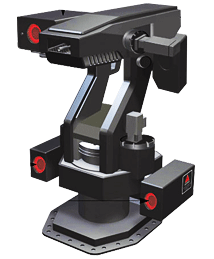| |
|
TTS: There's no AI coming anytime soon that will be able to distinguish reliably between an enemy combatant and some poor bastard on his way to the greengrocers. Simple motion sensors, on the other hand...
I realise that this response is informed by my general impression of an insufficiency in the military's giving a flying fuck anyway dept. as anything else.
Three developments which all have a bearing on both those points:
Israel's robot gun turrets on the border with Gaza.
Israel has begun deploying stationary robot gun-and-sensor installations along its borders with the Gaza Strip, according to reports ... The robot systems are said to mount cal-fifty (12.7mm) machine guns, protected by "armoured folding shields" until ready to fire.
...
According to Defence News Tel Aviv correspondent Barbara Opall-Rome, "each machine gun-mounted station serves as a type of robotic sniper, capable of enforcing a nearly 1,500-meter-deep no-go zone".
"The IDF's Southern Command is also considering adding Gill/Spike anti-tank missiles to extend the no-go zones to several kilometers, defense and industry sources here said."
The integrated robo-sniper network has reportedly been dubbed "See-Shoot" by the IDF, suggesting that asking questions isn't on the priority list.
"Nobody has any business approaching our border fence," an unnamed Israeli official told Opall-Rome. "It's well-understood that this area is off-limits..."
...
What's more, there seems to be a future plan for the Israeli gun systems to become true killer robots rather than just remote hardened weapon stations.
"At least in the initial phases of deployment, we're going to have to keep the man in the loop," an unnamed IDF commander reportedly told Opall-Rome. "We don't want to risk making tragic and politically costly mistakes with such a lethal system."
So that's one actual lethal autonomous robot system eventually planned for full operation.
Defense News quotes a spokesperson for The Israeli Information Center for Human Rights in the Occupied Territories:
Sarit Michaeli... is concerned about the deployment of such a system, regardless of whether it is operated in automatic or semi-automatic mode.
“There have been many cases in which people with no hostile or terrorist intentions were shot approaching the perimeter fence,” she said.
“Some attempted to enter Israel to find work, others suffered from disabilities, and still others were children who may have wandered into the forbidden areas. From a human rights perspective, the technology here is not as important as the need to evaluate each potential threat on a case by case basis.”
According to Michaeli’s statistics, since Israel’s withdrawal from Gaza, 14 unarmed Palestinians were killed by Israeli security forces at ranges of 100 meters to 800 meters from the perimeter fence. IDF statistics for that same period, however, show seven “terrorists killed” and 12 others wounded in the no-go buffer zone.
That's presumably all before the See-Shoot was deployed.
Here's another autonomous killer flying robot:

...the RQ/MQ-8 vertical takeoff and landing tactical unmanned air vehicle (VTUAV) commonly known as "Fire Scout".
The Fire Scout is a heavily modified small commercial 3/4-seat chopper, the Schweizer 333. The cockpit for outmoded flesh pilots has been removed and replaced by robo control and sensor systems, and an extra rotor blade added in order to achieve more lift. As it now stands, the Fire Scout can stay up for eight hours with just sensors and a targeting laser, or five hours with a load of weaponry in addition.
The robo-gunship can pack a fairly impressive arsenal for a small aircraft, including 70mm Hydra rocket pods or Hellfire laser-guided missiles. It truly is a flying robot, not a remote-controlled aircraft; Fire Scouts have made autonomous trial landings aboard US warships underway at sea, without any pilot guidance.

While the South Korean military are doing something similar to Israel in the DMZ.
A new gun-toting sentry robot, developed by Samsung Techwin Co. for the South Korean government, may soon be coming to a disputed border near you. The SGR-A1 robot uses a low-light camera and pattern recognition software to distinguish humans from animals or other objects and, if necessary, can fire its built‑in machine gun
...
The Samsung robot packs a 5-millimeter, Korean-made light machine gun. Should it detect an intruder, “the ultimate decision about shooting should be made by a human, not the robot,” says Yoo, who led the team that designed the robot. But the robot does have an automatic mode, in which it can make the decision. (my emphasis).
...
For use in the DMZ, the sentry bot doesn’t need to distinguish friend from foe. “When you cross the line, you’re automatically an enemy,” Yoo says.
Which is pretty much the same line as the Israeli bots on the Gaza border.
And naturally, they're looking for exports:
Myung Ho Yoo, a principal research engineer at Samsung’s Optics & Digital Imaging Division in Seongnam City, just southeast of Seoul, says the robot is the first of its kind to be commercialized ... Samsung is also looking to deploy the robot—minus the gun, but perhaps with some sort of nonlethal weapon—at airports, prisons, and nuclear power plants, among other places. There’s no price tag as yet, but Yoo estimates it will be in the US $80 000 to $100 000 range.
So coming to an Authorized Persons Only area near you soon? |
|
|